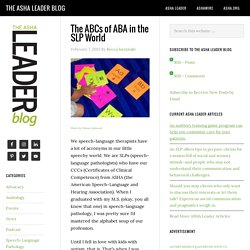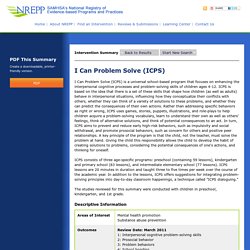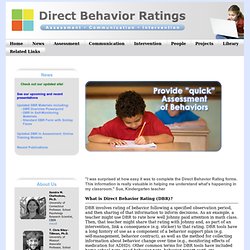

Kids Do Well if They Can Ross Greene #1. Presentations · NH CEBIS. SPABA SIG - Speech Pathology and Applied Behavior Analysis Special Interest Group. The ABCs of ABA in the SLP World. Photo by Chrissy Johnson1 We speech-language therapists have a lot of acronyms in our little speechy world.

We are SLPs (speech-language pathologists) who have our CCCs (Certificates of Clinical Competence) from ASHA (the American Speech-Language and Hearing Association). When I graduated with my M.S. (okay, you all know that one) in speech-language pathology, I was pretty sure I’d mastered the alphabet soup of our profession. Until I fell in love with kids with autism, that is. But I’m getting ahead of myself. ABA stands for Applied Behavioral Analysis. The Antecedent: What happened in the environment before the behavior occurred? The Behavior: This part involves describing the overt behavior that you see or want to see.
Consequence: What happens after the behavior? To help explain, let me share a couple examples. Say you are teaching a child to say “cookie.” Antecedent: You hold up a cookie and say, “cookie”Behavior: The child imitates “cookie”Consequence: You give the child the cookie. 0945 Ray Julie. 1374 Koch Carol (1) Meeting Every Special Need! Making Choices. Making Choices is a school-based, social skills training program designed to foster problem solving and pro-social behavior in children and interrupt developmental trajectories leading from early aggressive behavior and peer rejection to more serious behavioral problems.

The program targets two risk factors in the development of conduct problems--childhood deficits in social information processing skills and social rejection by pro-social peer groups. The Making Choices program was found to have a positive impact on post-test scores of social contact and cognitive concentration. Further, children who received the intervention also demonstrated significantly lower overt aggression.
Interaction effects indicated that children who scored lower in the pretest (identified as high risk) demonstrated significant post-test gains in social contact, social competence, cognitive concentration, and peer acceptance, as well as significant decreases in overt aggression. References: Intervention Summary - I Can Problem Solve (ICPS) Selected citations are presented below.

An asterisk indicates that the document was reviewed for Quality of Research. * Boyle, D., & Hassett-Walker, C. (2008). Reducing overt and relational aggression among young children: The results from a two-year outcome evaluation. Journal of School Violence, 7(1), 27-42. Chiou, V., Zissi, A., Xanthakou, Y., & Kaila, M. De Franco-Nierenberg, K., & Givner, A. (1998, August). Dincer, C., & Guneysu, S. Elias, L. Feis, C. . * Kumpfer, K. Kwon, Y. Punia, D., Balda, S., & Punia, S. (2004). Snir, D. (1977). 211376.pdf. Nas-cbiii-05-1001-009-r02.pdf. A review of effective interventions for reducing aggression and violence. DBR - Home. What is Direct Behavior Rating (DBR)?

DBR involves rating of behavior following a specified observation period, and then sharing of that information to inform decisions. As an example, a teacher might use DBR to rate how well Johnny paid attention in math class. Then, that teacher might share that rating with Johnny and, as part of an intervention, link a consequence (e.g. sticker) to that rating. DBR tools have a long history of use as a component of a behavior support plan (e.g. self-management, behavior contract), as well as the method for collecting information about behavior change over time (e.g., monitoring effects of medication for ADHD). Other common terms for DBR tools have included home-school note, good behavior note, behavior report card, etc... Why use Direct Behavior Rating?
DBR can facilitate communication among students, parents, and teachers because ratings can provide a simple, inexpensive, and flexible way to provide frequent feedback about behavior. National Center on Intensive Intervention.